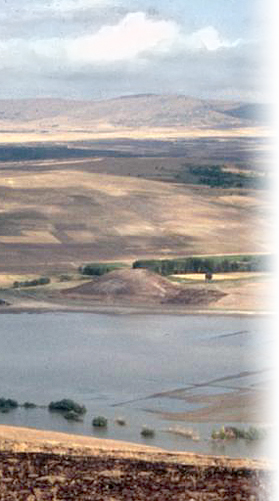
|

Çadır Höyük is one of many mounds in the central Anatolian plateau, but, unlike its southern counterparts (notably Çatal Höyük and neighboring sites), few of these superb multilayered sites have been dug by archaeologists. The largest and most famous of these central Anatolian mounds, as well as perhaps the most infamous, is nearby Alişar Höyük. The Oriental Institute of the University of Chicago sponsored excavations here in 1927 under a team led by Hans von der Osten and Erich Schmidt. Although the Prussian pair documented their work carefully, their goal was primarily to find impressive artifacts. Digging was conducted in the haphazard way often common to the times. In addition to tunneling, they also mined out a crater so enormous that a special railway needed to be built to move all of the dirt. Some of their findings were impressive, but, for all of the ruins that they sifted through, they fell short of the spectacular successes for which they had hoped. Digging ceased in 1932.
Scholarly interest in Alişar Höyük did not wane, though, as the large site clearly had much to tell us about the ancient societies and environment of the central Anatolian plateau. Dr. Ron Gorny, who, in the 1970's and 1980's, had spent much time exploring the many unexcavated mounds in Turkey, gained rights from the Turkish government and the Oriental Institute to reexamine the site. An initial survey of the mound in 1993 was followed the next year by a survey of the surrounding area, giving birth to the Alişar Regional Project. Smaller settlements found around the Alişar, Çadır, and Orta mounds showed that the large sites were once regional centers in a complex society that had called the Kanak Su basin home since Chalcolithic times.
The project shifted its focus to Çadır Höyük during the 1994 season, when rising waters caused by the new Gelingüllü Dam threatened the mound. Work there began as a salvage operation, though, fortunately, the new lake never quite reached its slopes. Opening a 2 meter by 20 meter step trench along the eastern slope, the archaeologists were pleased to find that survey surface finds identified what lay underneath with a high degree of accuracy. Furthermore, their findings encouraged them to revise their earlier assumptions about Çadır Höyük's importance as an archaeological site. Where they had no initial expectations to find major Chalcolithic Period remains, the ruins of just such a settlement were discovered only inches below the surface near the base of the mound. Megalithic stone architecture constructed during the Late Bronze Age showed, too, that this was no modest Hittite settlement.
After a hiatus from 1995 to 1997, excavations at Çadır Höyük were resumed to bring more of its secrets to light. Later seasons saw the opening of a new, wider step strench along the south slope, a square uncovering the Hittite gate on the north slope, and trenches revealing the Byzantine settlement on the citadel and in the fields below. Except for a 2007 research trip for the directors, excavations have continued every summer to the present.

After conducting the 1993 survey to gain an understanding of Çadır's habitation periods, we laid out a 1,000 by 1,000 meter grid over the mound and surrounding area. Generally we dig 10 by 10 meter squares within this grid, using evidence from the survey and nearby trenches to aide in their placement. Because Çadır Höyük is a multi-level site, some amount of disturbance and destruction of higher layers is unavoidable. We draw and photograph each major layer of the settlement before proceeding, when necessary, deeper into the mound. We document our excavations using a standard locus/feature system, and assign context priorities by a three-tier system. Sieved with a 0.5 cm screen are: 25% of Priority 3 (mixed) contexts, 50-75% of Priority 2 (partially sealed) contexts, and 100% of Priority 1 (sealed) contexts (except for samples taken for flotation). We give artifacts Field Catalog Numbers, which run consecutively for the entire site, before cleaning and conserving them. Then the artifacts are photographed, drawn and turned over to the appropriate specialist for study. The majority of the materials remain stored at the depot at the excavation house, although select objects are turned over to the Yozgat Museum.

Late Chalcolithic/Early Bronze:
About 600 square meters of the Late Chalcolithic and Early Bronze settlements at Çadır Höyük have been exposed as of 2008, yet only one structure has been positively identified as a domestic complex. Our primary goal in the Late Chalcolithic/Early Bronze transitional level is to find more evidence on domestic life, so as to be able to draw more conclusions about social stratification and the local power system.
Bronze Age:
Bronze Age excavation goals continue to revolve around definitively identifying the mound in its Hittite geography. Large casemate walls, substantial Hittite construction and exciting small finds are strong indicators that Çadır Höyük was an important Hittite settlement.
Iron Age:
Having found plenty of Middle and Late Iron Age material, but comparatively little from the periods immediately before and after, our goal for the Iron Age ecxavations is to better understand Çadır Höyük's transitions after the Hittite collapse and prior to the Byzantine community.
Byzantine Period:
As so many archaeologists actively excavate the prestigious and affluent poleis of the Byzantine Empire, our dig sheds light on more common Byzantine life in the smaller, agricultural communities of the Empire. Our excavation also affords the opportunity to trace the fortunes of this particular area of the plateau as the Medieval power environment changed around it.
|




